When most people think “electric vehicle,” they picture a sleek Tesla silently gliding down the road while its driver sips an oat-milk latte and smugly bypasses the gas station. But here’s the plot twist: EVs have been around way longer than Elon Musk — longer than Elon himself has been around, longer than the internet, and even longer than sliced bread. (Yes, your great-great-grandpa could have been rolling electric before it was cool.)
Back in the Day: The First Charge
The first practical electric cars popped up in the late 1800s, when horses were still the dominant horsepower. In the 1890s, electric vehicles were quiet, clean, and easier to start than those crank-handle gasoline monsters. By 1900, EVs accounted for about one-third of all vehicles in the U.S. Even Thomas Edison was in on the game, working on better batteries — because of course he was.
So what happened? A few things: Henry Ford perfected mass-production for gas cars, making them cheap and easy to buy. Gasoline became widely available. And, well, EVs faded into obscurity, becoming more of a museum piece than a driveway staple.
Today’s EV Landscape: Plugged In and Powered Up
Fast forward a century and here we are, back in the electric fast lane. EVs now range from budget-friendly compacts to luxury supercars that make grown adults giggle on acceleration. Charging infrastructure has expanded so much that it’s almost harder to not find a charging station in major cities.
Tesla still dominates headlines, but every major automaker — Ford, GM, Toyota, BMW, Hyundai — has skin in the EV game. And it’s not just cars: electric trucks, buses, delivery vans, and even semi-trailers are hitting the streets. Battery technology is improving, ranges are increasing, and the days of “range anxiety” are slowly fading into “range confidence.”
The Road Ahead: What’s Next for EVs
The future looks charged — pun very much intended. By 2035, several countries (and states like California) plan to ban the sale of new gas-powered cars altogether. Automakers are investing billions into EV research, aiming for longer ranges, faster charging, and even bidirectional charging so your car can power your home in a blackout.
Expect more affordable models, better battery recycling, and innovations like solid-state batteries that could slash charging times to minutes. Self-driving EV fleets may become as normal as hailing an Uber. And yes, flying electric taxis are in development — because apparently, we’re going full Jetsons.
From the cobblestone streets of the 19th century to today’s tech-packed highways, the electric vehicle has come full circle. It’s no longer a quirky alternative — it’s the next chapter in automotive history. And this time, it’s here to stay.
